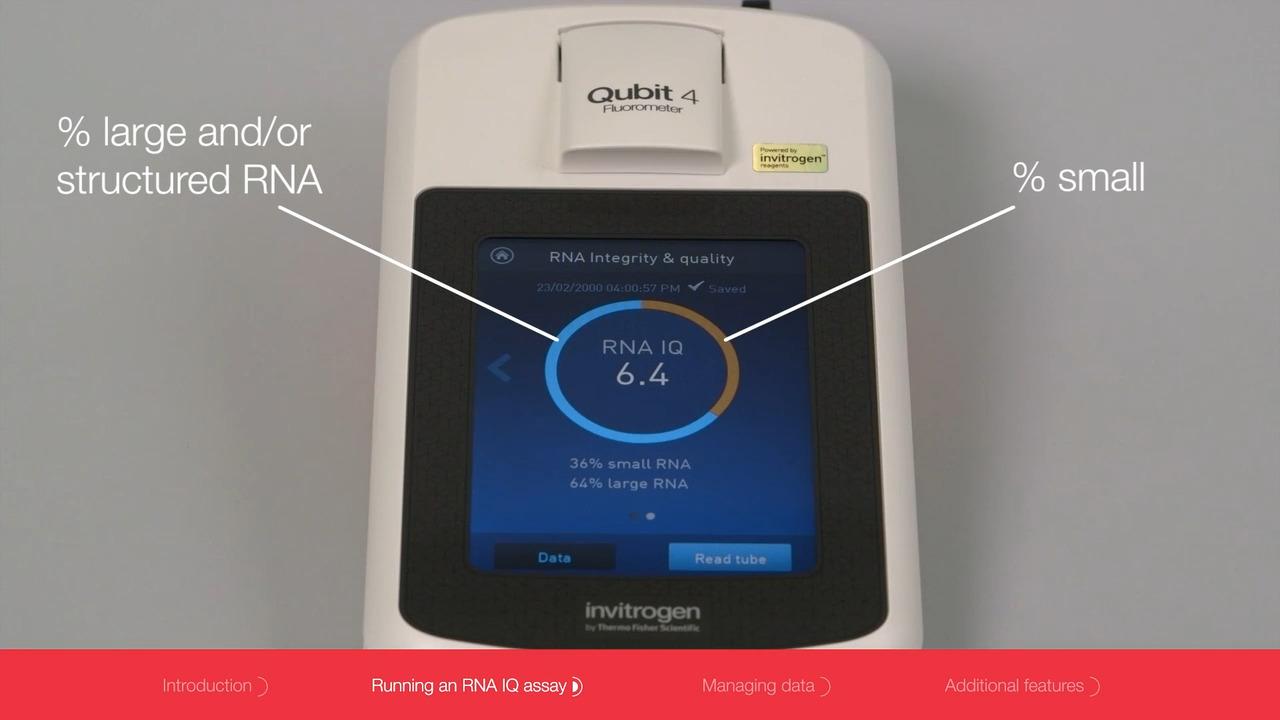
Quickly assess RNA integrity and quality
The Qubit RNA IQ Assay was developed to quickly assess the integrity and quality (IQ) of an RNA sample. It uses two dyes: one that binds to large, intact, and/or structured RNA, the other to small, degraded RNA.
RNA quality assay
Simple protocol
To use the Qubit RNA IQ Assay, simply add as little as 1 µL of your samples (containing 0.5–1.5 µg RNA) to the RNA IQ working solution and measure on the Qubit 4 or Qubit Flex Fluorometer. No special handling, tedious sample preparation, or waiting for results is required. A sample’s IQ score, a number between 1 and 10, represents the percentage of large to small RNA molecules in the sample.
Qubit RNA IQ assay results
The RNA IQ score is a value from 1 to 10, similar to other RNA quality scores. Based on a proprietary algorithm, it represents the ratio of large and/or structured RNA to small RNA in the sample. A low score (A) indicates that the sample consists of mainly small RNA while a high score (B) indicates that the sample consists mainly of large and/or structured RNA.
As shown in the table, the Qubit RNA IQ Assay can be far simpler and faster to use than other methods such as the Agilent™ Bioanalyzer™ system. In addition, the Qubit RNA IQ score is more consistent with RT-qPCR measures of RNA quality than the Bioanalyzer RNA integrity number (RNA), as demonstrated on the Sample Data page.
Protocols for measuring RNA sample quality with the Qubit RNA IQ Assay and the Agilent Bioanalyzer
Instrument and assay |
Qubit 4 Fluorometer and RNA IQ Assay |
Agilent 2100 Bioanalyzer™ instrument and RNA Nano Chip* |
|---|---|---|
Equipment and reagents required for assay* |
Qubit 4 Fluorometer |
Agilent 2100 Bioanalyzer instrument |
Qubit RNA IQ assay kit |
RNA 6000 Nano Assay Kit |
|
Pipettor |
Pipettor |
|
Qubit Assay tubes |
Microcentrifuge tubes |
|
|
Chip priming station |
|
|
IKA vortexer |
|
|
Microcentrifuge |
|
|
Computer |
|
|
Heating block or water bath |
|
|
RNase-free water |
|
Equipment setup |
Turn on Qubit 4 Fluorometer |
Replace the syringe at the chip priming station with each new DNA kit |
Adjust the base plate of the chip priming station |
||
Adjust the syringe clip at the chip priming station |
||
Adjust the Bioanalyzer chip selector |
||
Set up the vortex mixer |
||
Start the software before you load the chip |
||
Sample prep time |
~5 minutes |
~30-45 minutes |
Sample prep |
1. Prepare Qubit RNA IQ working solution by adding RNA IQ dye to RNA IQ buffer |
1. Prepare RNA ladder |
2. Add sample [1-20 uL (0.5–1.5 ug)] and standards to Qubit RNA IQ working solution |
2. Prepare the gel (step includes 10 min centrifugation) |
|
|
3. Prepare the gel-dye mix (step includes 10 min. centrifugation) |
|
|
4. Load the gel-dye mix into the chip |
|
|
5. Load marker into the chip |
|
|
6. Load the RNA ladder and sample(s) (step includes 1 min IKA vortexer) |
|
Sample stability |
~1 hour |
Use chip within 5 minutes |
Analysis run time |
<4 seconds per sample |
30 minutes per chip |
Regular maintenance |
None |
Check the performance of the chip priming station by applying the seal test on a monthly basis |
For electrophoresis assays: clean electrodes on a daily basis using the electrode cleaner |
||
Thoroughly clean electrodes on a monthly basis using a toothbrush and distilled water |
||
Clean the focusing lens once a month (or after any liquid spill) using isopropanol |
||
Product(s) required for maintenance |
None |
RNaseZAP (electrode cleaning) |
* Compiled from Agilent G2938-90037 and G2946-90003 user manuals and Thermo Fisher Scientific MAN0017210 quick reference card. |
||
Sample data
This data example shows that the two reagents in the Qubit RNA IQ Assay are highly specific to large and small RNA respectively, and that RNA IQ scores increase appropriately as the percentages of large RNA increase.
This data example shows that, with exposure to RNase A, an RNA sample degrades over time and its RNA IQ score drops. The degradation is faster with higher doses of RNase A, as would be expected.
Combine Qubit fluorometry with NanoDrop UV fluorescence to measure RNA quantity, quality, and purity
For Research Use Only. Not for use in diagnostic procedures.
